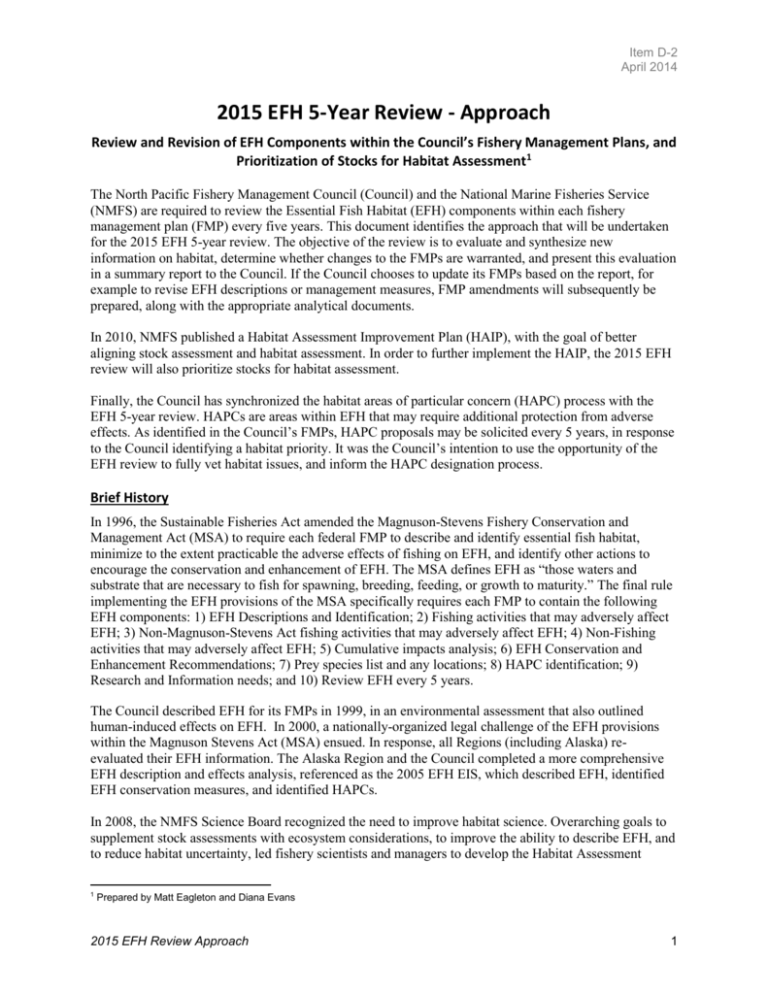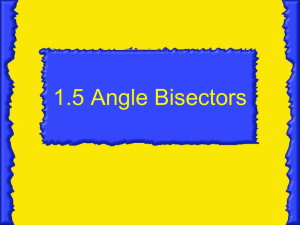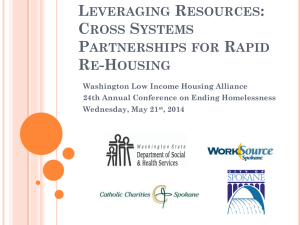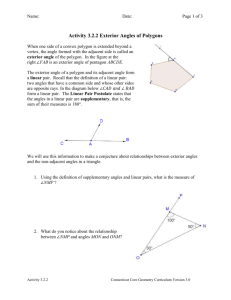5-Year Review - North Pacific Fishery Management Council
advertisement

Item D-2 April 2014 2015 EFH 5-Year Review - Approach Review and Revision of EFH Components within the Council’s Fishery Management Plans, and Prioritization of Stocks for Habitat Assessment1 The North Pacific Fishery Management Council (Council) and the National Marine Fisheries Service (NMFS) are required to review the Essential Fish Habitat (EFH) components within each fishery management plan (FMP) every five years. This document identifies the approach that will be undertaken for the 2015 EFH 5-year review. The objective of the review is to evaluate and synthesize new information on habitat, determine whether changes to the FMPs are warranted, and present this evaluation in a summary report to the Council. If the Council chooses to update its FMPs based on the report, for example to revise EFH descriptions or management measures, FMP amendments will subsequently be prepared, along with the appropriate analytical documents. In 2010, NMFS published a Habitat Assessment Improvement Plan (HAIP), with the goal of better aligning stock assessment and habitat assessment. In order to further implement the HAIP, the 2015 EFH review will also prioritize stocks for habitat assessment. Finally, the Council has synchronized the habitat areas of particular concern (HAPC) process with the EFH 5-year review. HAPCs are areas within EFH that may require additional protection from adverse effects. As identified in the Council’s FMPs, HAPC proposals may be solicited every 5 years, in response to the Council identifying a habitat priority. It was the Council’s intention to use the opportunity of the EFH review to fully vet habitat issues, and inform the HAPC designation process. Brief History In 1996, the Sustainable Fisheries Act amended the Magnuson-Stevens Fishery Conservation and Management Act (MSA) to require each federal FMP to describe and identify essential fish habitat, minimize to the extent practicable the adverse effects of fishing on EFH, and identify other actions to encourage the conservation and enhancement of EFH. The MSA defines EFH as “those waters and substrate that are necessary to fish for spawning, breeding, feeding, or growth to maturity.” The final rule implementing the EFH provisions of the MSA specifically requires each FMP to contain the following EFH components: 1) EFH Descriptions and Identification; 2) Fishing activities that may adversely affect EFH; 3) Non-Magnuson-Stevens Act fishing activities that may adversely affect EFH; 4) Non-Fishing activities that may adversely affect EFH; 5) Cumulative impacts analysis; 6) EFH Conservation and Enhancement Recommendations; 7) Prey species list and any locations; 8) HAPC identification; 9) Research and Information needs; and 10) Review EFH every 5 years. The Council described EFH for its FMPs in 1999, in an environmental assessment that also outlined human-induced effects on EFH. In 2000, a nationally-organized legal challenge of the EFH provisions within the Magnuson Stevens Act (MSA) ensued. In response, all Regions (including Alaska) reevaluated their EFH information. The Alaska Region and the Council completed a more comprehensive EFH description and effects analysis, referenced as the 2005 EFH EIS, which described EFH, identified EFH conservation measures, and identified HAPCs. In 2008, the NMFS Science Board recognized the need to improve habitat science. Overarching goals to supplement stock assessments with ecosystem considerations, to improve the ability to describe EFH, and to reduce habitat uncertainty, led fishery scientists and managers to develop the Habitat Assessment 1 Prepared by Matt Eagleton and Diana Evans 2015 EFH Review Approach 1 Item D-2 April 2014 Improvement Plan (May 2010). Just recently, the Alaska Region decided to prioritize stocks for habitat assessment. In 2010, an EFH 5-year Review evaluated new information on EFH since the EFH EIS, assessed information gaps and research needs, and identified whether any revisions to EFH were needed or suggested. Acting on this report, the Council initiated FMP amendments for all six Council FMPs, which updated several species descriptions, changed the HAPC process timing to occur simultaneously with each 5-year review, and revised EFH research priorities (implemented Oct 2012). The EFH review also identified that further investigation is needed for red king crab habitats, which the Council has been following up on a separate track. Currently, the 2015 EFH 5-year Review is developing new analytical methods to describe EFH, updating the 2005 EFH Fishing Effects Model, and investigating non-fishing effects on EFH. EFH Regulations Federal regulations implementing the EFH provisions of the MSA require that a review and revision of EFH components be completed every 5 years (50 C.F.R. 600.815(a)(10)). The last comprehensive review of EFH was completed in 2010. In order to comply with this condition, NMFS is initiating work on the next 5-year review, in order to produce a summary report for the Council in 2015 (a tentative timeline is included at the end of this paper). The regulations also state that EFH information should be reported annually in the Stock Assessment Fishery Evaluation (SAFE) Reports. The SAFE reports for the Council’s FMPs compile the most recent scientific assessment and research for groundfish, crab, and scallop managed species. This scientific information, and catch and survey data by species, are the current basis for EFH descriptions. 50 CFR 600.815 (a)(10) Councils and NMFS should periodically review the EFH provisions of FMPs and revise or amend EFH provisions as warranted based on available information. FMPs should outline the procedures the Council will follow to review and update EFH information. The review of information should include, but not be limited to, evaluating published scientific literature and unpublished scientific reports; soliciting information from interested parties; and searching for previously unavailable or inaccessible data. Councils should report on their review of EFH information as part of the Annual Stock Assessment and Fishery Evaluation (SAFE) report prepared pursuant to § 600.315(e). A complete review of all EFH information should be conducted as recommended by the Secretary, but at least once every 5 years. Proposed Approach The 2015 EFH 5-year Review will evaluate EFH components in the six Council FMPs, with respect to new information. The Council’s six FMPs are the following: Groundfish of the Bering Sea and Aleutian Islands Management Area (BSAI Groundfish) Groundfish of the Gulf of Alaska (GOA Groundfish) Bering Sea/Aleutian Islands King and Tanner Crab (BSAI Crab) Scallop Fishery off Alaska (Scallop) Salmon Fisheries in the EEZ off the Coast of Alaska (Salmon) Fish Resources of the Arctic (Arctic) While the EFH review will evaluate all EFH aspects in the Council’s FMPs, there are three primary areas that have been identified for particular focus: the EFH description methodology, the fishing effects model, and non-fishing effects. In order to make progress on these three separate areas, three technical subgroups 2015 EFH Review Approach 2 Item D-2 April 2014 have been constituted, whose tasks are described further below. The output of the EFH description methodology group and the fishing effects model group will also be provided to stock assessment authors for their complete review of managed species in each of the Council’s six FMPs. Together, all of these work products, will be synthesized in the EFH 5-year review summary report and presented to the Council. An interagency steering committee, or EFH workgroup, has been identified, to ensure that the review is completed consistently across FMPs and across issues. Once the draft summary report is finalized, the Council will be able to determine what action, if any, is warranted based on the report. If the Council decides to initiate FMP amendments to update EFH components in the FMPs, or consider additional EFH mitigation measures, the amendments and associated analysis will proceed through the normal Council process. Once the draft summary report is prepared, the Council can also use the report to identify habitat priorities for a HAPC call for proposals. The Council has a formalized process identified in its FMPs for selecting HAPCs. Under this process, the Council periodically considers whether to set priority habitat types (every five years, or on a schedule established by the Council). If so, the Council initiates a call for proposals for HAPC candidate areas that meet the specific priority habitat type. Sites proposed under this process are reviewed, and the Council may choose to select HAPC proposals for analysis and implementation. The Council revised the HAPC process in 2012, with the intent to allow the EFH 5-year review process to inform the designation of HAPC priorities. The EFH review approach, and HAPC process, is depicted graphically in the figure that follows. 2015 EFH Review Approach 3 Item D-2 April 2014 EFH Descriptions EFH descriptions for all managed species within the Council’s six FMPs will be re-evaluated as part of the 5-year review. Since the 2010 EFH review, new habitat information is available that may allow EFH descriptions to be refined for some stocks. The EFH final rule identified four types of information on which to base EFH descriptions, categorized into levels: Level 1 – distribution data are available for some or all portions of the geographic range of the species Level 2 – Habitat-related densities of the species are available Level 3 – Growth, reproduction, or survival rates within habitats are available Level 4 – Production rates by habitat are available Currently, stocks managed in the Council FMPs are all described either using Level 1 distribution data, or are stocks for which no EFH information is available at all. The technical subgroup for EFH description methodology is tasked with developing a methodology to apply level 2 and/or level 3 data to stocks that have additional information is available. The subgroup will determine whether a different methodology is warranted for different FMPs, for example, groundfish, salmon, crab, or scallop species. Once the subgroup has developed new methodologies for EFH descriptions using higher levels of data, each stock assessment author, or other primary staff if so designated, can review available data for his/her species, and determine whether it is possible to refine the existing EFH description with a higher level of data. The stock assessment author will review the existing EFH text and map descriptions, as well as the associated habitat data that is contained within the FMP. The review will take into account new information from current research, recent SAFE reports, and other appropriate sources. Should information be available to define or refine EFH, a new EFH description will be prepared as a recommended revision resulting from this review process. The stock assessment authors will also identify information gaps and research needs, and will be given the opportunity to provide any recommendations to the Council as to HAPC priorities. For the preparation of the EFH Summary Report, each stock will be reviewed primarily by the technical subgroup, and the stock assessment author (or other designated primary staff). Should the Council decide to initiate an amendment to the FMP to revise EFH for that stock, the revised description, and associated analysis, will be vetted through the relevant Plan Team, in addition to the Council process. Fishing Effects Model The EFH review will also re-examine the Long-term Evaluation of Fishing Effects Index (LEI) model, which was used in the 2005 EFH EIS to determine whether fishing has adverse effects on EFH. The Fishing Effects model technical subgroup is tasked with reviewing the 2005 fishing effects model, and updating it to make it easier to use. The subgroup will then compile updated information on significant input parameters, and re-run the model using the updated information. The output of the revised model will be written up in the EFH summary report. It will also be provided to stock assessment authors to consider whether any substantial new information is available to augment the 2005 EFH EIS analysis of whether fish stocks show any evidence of adverse effects caused by fishing. Non-fishing Effects The EFH review will also reassess non-fishing activities that have an adverse effect on EFH. The technical subgroup on non-fishing effects will review activities affecting EFH, and will update existing literature, the EFH Conservation Recommendations for non-fishing activities, and potentially develop a geospatial mapping tool. 2015 EFH Review Approach 4 Item D-2 April 2014 Habitat Assessment Priorities In conjunction with the EFH description review, stock assessment authors will be asked to evaluate stocks using a series of scoring rubrics developed as part of the HAIP, which assess benefits, research, habitat condition, ecological importance, and value. Each stocks final score and percentage will be compared in order to establish priorities for habitat assessment. In addition to prioritization, the process will allow identification of inadequacies and information gaps relevant to the habitat of stocks. Council action based on the EFH Summary Report If the review indicates that substantial new information is available, the report will recommend potential revisions for each relevant FMP. For example, this could take the form of revised EFH descriptions for certain stocks, or an update to the analysis of the effects of fishing or non-fishing on EFH. The Council will then consider this information, and initiate action (proposed FMP amendments) if it is warranted, or conclude that no further action is needed. Potential outcomes of the 2015 5-year review New methodology for describing EFH with data other than distribution data New EFH descriptions for some stocks, for which more habitat information is available Updated habitat information on stocks in the FMPs A priority list of stocks habitat assessment Updated fishing effects model, may provide new information as to whether or not fishing may be having more than minimal and less than temporary effects on EFH A Council discussion of whether to identify HAPC priorities, and initiate a call for HAPC proposals Improved means to assess non-fishing effects on EFH 2015 EFH Review Approach 5 Item D-2 April 2014 Tentative Timeline Sep 2013 Jan-Jul 2014 Mar 2014 Mar-Sep 2014 Apr 2014 May 2014 Aug 2014 Sept 2014 Oct 2014 Oct-Dec 2014 end Dec 2014 Jan-Feb 2015 March 2015 Apr 2015 Apr-May 2015 June 2015 Jun - Sep 2015 Oct 2015 Dec 2015 February 2015 April 2015 Overview of 2015 EFH review approach to Groundfish Plan Teams, including draft analytical concepts, and initial identification of potential data sets. Review of LEI model (funded by EFH grant) AFSC, others identify staff for steering committee and subgroups for the three focal areas (EFH description methodology, fishing effects model, non-fishing effects). Steering committee and subgroups develop methods, applications, and spatial and analytical tools. Update to Council on 2015 EFH review approach Overview of 2015 EFH review approach to Crab Plan Team Draft LEI results available to Fishing Effects subgroup Preliminary update to Groundfish Plan Teams on fishing effects results and EFH description methodology, draft habitat priorities questionnaire. Coordinate with Crab, Scallop, Salmon, and Arctic leads and assessment authors. Update to Ecosystem Committee, SSC if appropriate. Incorporate feedback and finalize subgroup recommendations for EFH description methodology, fishing effects, and non-fishing effects. Subgroup recommendations complete and distributed to authors Stock assessment authors review EFH for target stocks under the 6 Council FMPs Assemble and release draft summary report Draft Summary Report for Council review (incl Ecosystem Committee, SSC) Council will consider setting HAPC priorities, and initiating a call for HAPC proposals Revise report based on Council recommendations. Final Summary Report for Council Review. Council decision as to whether to initiate action based on report (e.g., initiate analysis of FMP amendments to implement EFH changes) If appropriate, initial screening of HAPC proposals for adherence to Council priorities; Council selects proposals to go forward for review If requested, staff prepare amendment analysis for EFH changes Staff and Plan Teams review HAPC proposals for ecological merit, and socioeconomic and enforcement issues Initial review draft of FMP amendments for EFH changes Council decision on whether to formulate HAPC proposals into an amendment analysis Council final action on FMP amendments for EFH changes Initial review of HAPC amendment analysis Council final action on HAPC amendment analysis 2015 EFH Review Approach 6







